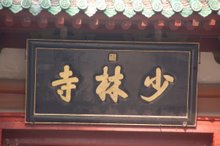
Much of what we currently recognize about Shaolin – and in fact about “Zen” Buddhism – derives from the second eminent monk of Shaolin, Bodhidharma, who was simply called ‘Damo,” also called “Dharma.” In Song of Enlightenment, Yongjia Xuanjue writes that Bodhidarma was the 28th patriarch in the line of succession from Shakyamuni Buddha – the founder of Buddhism.
According to some sources Damo had come from India to China in 527 A. D., to be the first patriarch of Buddhism. After arriving in China from India, Damo – the third son of a prominent Indian king – entered China by way of Guangzhou and then to Nanjing, the capital of the Liang dynasty. Upon his arrival Liang emperor, Liangwu reportedly interviewed Damo, asking him 3 questions; which evoked unsatisfactory answers from Damo.
"What is the highest meaning of noble truth?" Bodhidharma answered, "There is no noble truth."
The emperor then asked Bodhidharma, "Who is standing before me?" Bodhidharma answered, "I don't know."
The emperor then asked Bodhidharma, "How much karmic merit have I earned by ordaining Buddhist monks, building monasteries, having sutras copied, and commissioning Buddha images?"
Bodhidharma answered, "None."
When Liangwu dismissed Damo, refusing anymore to listen to him, Damo crossed the Yangtze river into Luoyang – the capital of the Beiwei dynasty. From there he made his way to Shaolin Temple.
Rather than take up residence in the Temple hall, Damo instead took up residence in a cave on Wuru Peak, in the Songshan Mountains. He remained in this cave for nine years, facing the cave wall, studying, and meditating. During this time he received Enlightenment, and from it developed a new system of Chinese Buddhism, called “Chan.” Westerners know this sect of Buddhism by its Japanese name, “Zen.”
At the time of Damo’s arrival Shaolin spent long hours meditating and did a sitting qigong without much physical exercise. Damo suggested that physical exercise should be included in the priests’ daily regimen in order to prevent the blood and qi from stagnating, this included the incorporation of tai qi, a form of martial arts practice.
While it is generally acknowledged that Damo encouraged the incorporation of regular physical exercise into the discipline of monastery life, Chinese scholars over the centuries have vigorously denied that Damo is the person responsible for bringing Kung Fu to Shaolin. In fact there are many stories about the prowess of two particular Shaolin monks – Huiguang and Sengchou – who were at Shaolin around the same time as Damo. These two are said to have actually arrived at Shaolin during the time of Batuo. Nevertheless, Shaolin Kung Fu is known to have been an integral part of monastery life, since very early in the history of the Temple.
In 621 Shaolin monks contributed to solidifying the stronghold of the Tang Dynasty, when they fought for Taizong – who ultimately became the second Tang Emperor – at the Battle of Qianglingkou. Since that time, by official decree, Shaolin Temple has been permitted to practice Kung Fu and to have “Fighting Monks” among its ranks.
The history of Shaolin Temple is long and extensive. Over the course of its 1500 year history it has seen numerous periods of growth and decline. Many temple buildings and artifacts have been destroyed in conflicts – and in fact between 1600 and 1928 three major fires devastated the compound. In the most recent fire, set by the warlord Shi Yousan in 1928, the “Buddha Worshipping Hall,” bell tower, drum tower, Daxiong Palace and over a thousand copies of Buddhist classics were destroyed.
During the Cultural Revolution temples were closed, leaving the Temple barren for many years. In the period seventies and eighties the movie industry kindled an interest in the martial arts, Chinese Kung Fu in general, and – perhaps because of the popularity of stars like Bruce Lee and Jet Li – Shaolin Kung Fu in particular. Gradually the Chinese government undertook the renovation of the compound – with added assistance of many enthusiasts from the West. The latest round of renovatins were completed in 2005, according to Handbook for Shaolin Temple Tour, edited by the Temple’s current abbot, Shi Yongxin.
We visited and photographed much of Shaolin Temple in November 2006, and from that visit compiled a “living tour” of the Personal Residence Compound. In doing so, we have tried to organize and group pictures in such a way as to give you a sense of walking through the compound from front to back.
 Shaolin Temple is located in the Shaoshi Forest at the foot of the Shongshan Mountain, in China’s Henan Province, about 13 kilometers northwest of the city of Dengfeng. It was first established in 495 a.d., when Emperor Xiaowen ordered that a temple be built for an Indian dhyana master named Batuo.
Shaolin Temple is located in the Shaoshi Forest at the foot of the Shongshan Mountain, in China’s Henan Province, about 13 kilometers northwest of the city of Dengfeng. It was first established in 495 a.d., when Emperor Xiaowen ordered that a temple be built for an Indian dhyana master named Batuo.


































